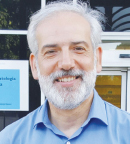THE ADDITION OF 6 months of maintenance chemotherapy in the treatment of rhabdomyosarcoma improved 5-year survival by 13%, in the European RMS2005 Maintenance study reported at the 2018 ASCO Annual Meeting.1 “At the end of this long, not-easy study, we concluded that maintenance is an effective and well-tolerated treatment for children with high-risk rhabdomyosarcoma,” said Gianni Bisogno, MD, PhD, of the University Hospital of Padova, Italy, during his Plenary Session presentation.

“Maintenance therapy represents a well-tolerated, effective strategy in high-risk rhabdomyosarcoma.”— Gianni Bisogno, MD, PhD
Tweet this quote
Although the findings have changed the standard of care in Europe, U.S. specialists are unsure yet of the relevance of the study to oncologists in this country, who tend to use a different chemotherapy backbone. It is possible, they pointed out, that the outcomes were improved by a longer duration of therapy and not maintenance, per se. However, the lower toxicity of maintenance could be an alternative to the protracted intensive chemotherapy used in the United States.
Rhabdomyosarcoma is rare, occurring in just 350 children diagnosed in the United States each year and in some adults. Although it is an aggressive tumor, modern intensive therapy results in initial complete response in more than 90% of patients. However, about one-third of these patients relapse within 2 to 3 years, and after relapse, most patients cannot be cured, Dr. Bisogno said during an ASCO press briefing.
Study Details
MAINTENANCE THERAPY FOR RHABDOMYOSARCOMA
- The European Paediatric Soft Tissue Sarcoma Study Group evaluated maintenance therapy after induction chemotherapy in 371 children with high-risk rhabdomyosarcoma.
- The addition of 6 months of maintenance chemotherapy improved overall survival at 5 years from 73.7% to 86.5% (HR = 0.52; P = .011). Disease-free survival showed a trend for improvement, from 69.8% with standard treatment to 77.6% with maintenance therapy (HR = 0.68; P = .0613).
- The addition of maintenance did not seem to increase toxicity.
THE EUROPEAN PAEDIATRIC Soft Tissue Sarcoma Study Group conducted the phase III RMS2005 Maintenance study from 2006 to 2016. The study enrolled 371 patients < 21 years of age (79% were ≤ 10 years old) with rhabdomyosarcoma considered to be at high risk for recurrence, primarily because they had large tumors located in difficult-to-treat sites or unfavorable alveolar histology.
Patients received 9 cycles of intensive chemotherapy, radiotherapy, and surgery. Those who achieved a complete radiographic response were then randomized to receive 6 months of maintenance therapy with intravenous vinorelbine (25 mg/m2/wk) and oral daily low-dose cyclophosphamide (25 mg/m2) or no further treatment. The initial chemotherapy backbone included ifosfamide, vincristine, and dactinomycin, with or without doxorubicin, for 9 cycles.
Improvement in Disease-Free Survival
FIVE YEARS AFTER diagnosis, the disease-free survival rate was 69.8% in the standard-treatment arm vs 77.6% in the maintenance arm (hazard ratio [HR] = 0.68; P = .0613), showing a trend for an absolute benefit of 8%. The overall survival rate was 86.5% vs 73.7% (HR = 0.52; P = .011), a statistically significant 13% increase in this important endpoint, Dr. Bisogno reported.
Maintenance treatment actually resulted in less anemia; neutropenia and thrombocytopenia (ie, less need for transfusions); fewer infectious episodes; and no cardiac, hepatic, gastrointestinal, or renal toxicity compared to the prior intensive chemotherapy, he said.
“Maintenance therapy represents a well-tolerated, effective strategy in patients with high-risk rhabdomyosarcoma. This study establishes a new standard of treatment for patients with high-risk disease, at least in the European Union,” Dr. Bisogno said. ■
DISCLOSURE: Dr. Bisogno has served as an advisor to Clinigen Group and received travel expenses from Jazz Pharmaceuticals.
REFERENCE
1. Bisogno G, et al: Maintenance low-dose chemotherapy in patients with high-risk rhabdomyosarcoma. 2018 ASCO Annual Meeting. Abstract LBA2. Presented June 3, 2018.


